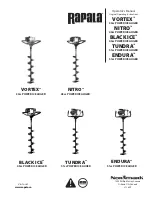
-9-
CHECKING OUT YOUR TRANSISTOR/DIODE TESTER
The following is a simple procedure for testing your DT-100. If the tests fail, refer to the troubleshooting guide
for help.
Diode Operation:
1. Place the switch in the diode position. Short the
black and red leads together and push in the test
button. The diode test LEDs should alternately go
on at about a 1Hz rate.
2. Connect the red and black leads to any good
diode. Only one LED should flash identifying the
red lead connection (anode or cathode).
Reversing the leads should cause the other LED
to flash.
Transistor Operation:
(using leads)
1. Place the switch in transistor position. Short the
yellow (B) and black (E) leads together. Press the
test button. Vary the base current control. The
NPN lamp should light with the switch in NPN and
the PNP when in PNP position.
(using socket)
2. Place a known good transistor in the test socket
with the Emitter in E, Base in B and Collector in C
pins. Be sure none of the leads are shorting. Vary
the base current control. The OK LED should
light. Note that on NPN transistor, the NPN lamp
also will glow very slightly. This indicates the base
current. The higher the beta of the transistor, the
lower the base current, and thus, lower intensity.
The base current control should be adjusted for
the lowest setting with the OK lamp glowing.
OPERATING INSTRUCTIONS
The DT-100 is a dynamic transistor and diode tester. It features in-circuit testing and polarity indicators for both
transistors and diodes.
Diode Testing
1. Place switch in diode position.
2. Connect diode to red and black leads.
3. Push in test switch. One diode LED should blink
and identify whether the cathode or anode is
connected to the diode (red) lead.
4. If both LED lamps blink, then the diode is shorted.
5. If neither lights, then the diode is open.
Transistor Testing
The DT-100 can measure transistors in or out of
circuit. It will identify NPN or PNP by a simple
adjustment.
Transistor testing - Out of Circuit
1. Place switch in transistor position.
2. Place transistor in socket or attach to C, B, E
leads. If collector C, base B and emitter E are not
known, assume B is the center lead on small
plastic transistors and C the metal case or tab on
power transistors.
3. Push in test button. Adjust the base current control
so that OK
LED lights. This indicates a good
transistor.
4. If OK lamp does not light, then adjust the base
current control that either NPN or PNP LED lights.
This happens at minimum or maximum position of
the control setting. This will indicate transistor
type. Place switch to NPN if the NPN lamp lights,
to PNP if PNP lamp is lit.
5. If no lamps light, the transistor is open or we have
not identified the base lead. Repeat assuming
another lead as base.
6. When the transistor is shown to be OK, the base
current control gives an indication of transistor
beta. The lower the setting relative to another
transistor, the higher the beta. Lamps NPN and
PNP measure base current. Higher base current
results in a brighter LED. It also indicates if
current is entering or leaving the base, thus NPN
or PNP respectively will light.
Transistor Testing - In Circuit
The DT-100 will test transistors in circuit provided the
base biasing resistance is greater than 100 ohms.
Simply follow the previous procedure for testing out
of circuit transistors. Do not apply power to circuit of
transistor or diode under test. The DT-100 will supply
the necessary power.






























